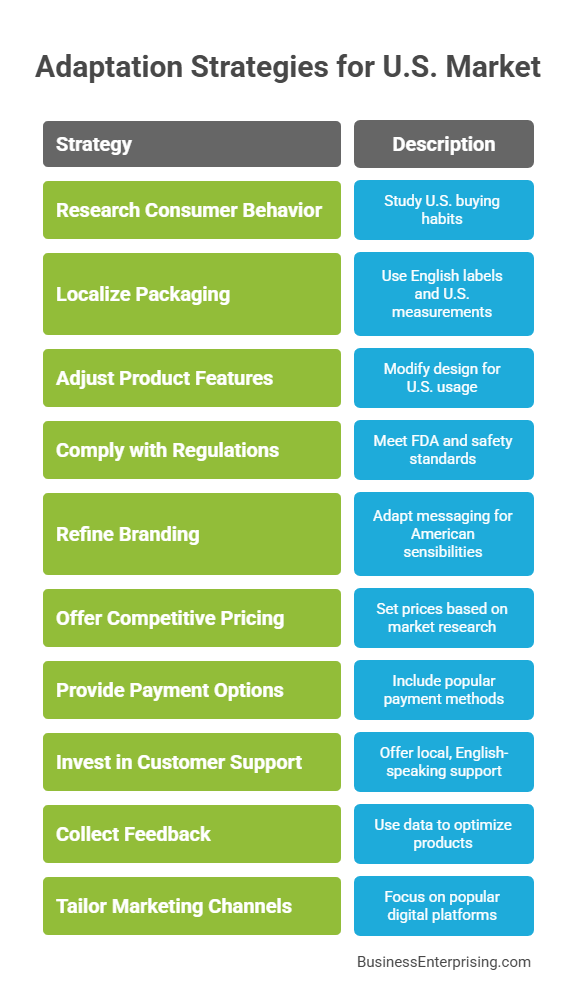
Additionally, Americans value convenience, clarity, and trust. If your product doesn’t meet these expectations, it may struggle to gain traction. Therefore, it’s important to review every aspect of your product. This includes packaging, features, pricing, and how you communicate your value.
Your product may already do well in other markets. However, that doesn’t guarantee it will connect with U.S. buyers. You’ll need to approach this market with fresh eyes. Start by learning what your target audience wants. Then adjust based on feedback, testing, and local research.
Also, think about how people find and buy products. Online shopping plays a big role in consumer habits. Therefore, product pages, visuals, and payment options matter as much as product quality. Americans often expect fast shipping, simple returns, and easy-to-understand benefits.
Adapting doesn’t mean changing your entire business. It means fine-tuning the details that help your product stand out. By doing this, you make it easier for U.S. buyers to trust and try what you offer. Additionally, the right adjustments can lead to stronger results and long-term growth.
Your goal is to enter the market with confidence, not guesswork. With thoughtful changes and a flexible approach, your product has a better chance to succeed.
Understanding American Consumer Behavior and Preferences
Understanding how Americans think and shop can help you succeed in the U.S. market. Cultural values, trends, and habits shape what people buy. While price matters, U.S. consumers often care more about convenience and quality. Many prefer speed and ease when deciding what to purchase.
However, lifestyle trends vary across the country. Urban buyers often prioritize technology and sustainability. Meanwhile, suburban and rural shoppers may value function and family-friendly features. Therefore, it’s important to research your target regions before launching a product.
Americans also expect personalized service and clear communication. You’ll notice they favor brands that reflect their values or solve a problem. Additionally, product reviews and social proof influence their decisions. People often check what others think before spending their money.
You should also think about shopping habits. While many still visit stores, online shopping keeps growing fast. Because of this, mobile-friendly product pages and fast shipping make a big difference. Keep in mind that Americans like having options, but not too many. Too much choice can overwhelm and slow down sales.
Regional preferences can also affect how your product performs. For example, flavors, styles, and seasonal items may appeal more in some areas than others. Therefore, adapting products for US consumers sometimes means offering slight variations by location.
Understanding these details helps you connect with your audience. When you meet people’s needs and habits, they’re more likely to buy. While trends shift over time, paying attention to behavior gives you an edge. As you learn what works, you can keep refining your approach for better results.
Localizing Product Features and Design
When adapting products for US consumers, localizing product features and design can make a big difference in market success. American shoppers often expect clear, simple packaging with easy-to-read labels. They also value information about ingredients, benefits, and usage. If your packaging uses non-standard sizes or foreign measurements, consider converting them to U.S. standards.
Additionally, product size can impact how customers perceive value. While some consumers prefer bulk sizes, others want convenience and portability. Therefore, offering multiple size options can help meet different preferences. You may also find that certain product colors work better in the U.S. Color meanings vary by culture, so test what appeals to your audience.
Functionality is another area to review closely. Does your product align with how Americans typically use similar items? For example, appliances should fit standard outlets and shelf sizes. Packaging should also be easy to open and store. These details seem small but affect the buying decision.
Usability often drives repeat purchases. If customers find your product confusing or difficult, they may not try it again. Therefore, make instructions short and visual when possible. Americans often expect products to be intuitive and quick to use. They don’t want to guess how something works.
Also, think about accessibility. Products that work well for a wide range of users often do better in the long run. Small adjustments to labeling, grip, or packaging design can help. You want your product to feel familiar but still offer something different. When you make thoughtful design changes, you improve your chances of standing out.
Compliance with U.S. Regulations and Standards
When you enter the U.S. market, meeting local regulations is not optional. You must follow all legal and industry-specific requirements. These rules protect consumers and help create a level playing field. Before you sell anything, make sure your product meets the right standards.
For food, cosmetics, and health products, FDA approval may be required. If your product makes medical claims, extra steps often apply. Additionally, U.S. labeling guidelines are strict. You must list ingredients, net weight, and directions clearly. Labels must be in English and easy to read.
Therefore, review your packaging carefully before launch. Incorrect labels can delay entry or lead to fines. Safety certifications are also important. Electronics, toys, and personal care items often require testing. Products must meet federal and sometimes state-level safety standards. If you ignore these rules, your product may be rejected or recalled.
Adapting products for US consumers also means understanding packaging laws. Your design must meet both marketing goals and legal needs. For example, child-resistant packaging may be required for some goods. Additionally, warning labels must follow specific formats depending on the product type.
You should also check if your industry has extra standards. Some sectors require product registration or proof of testing. These steps can take time, so plan ahead. U.S. customs may also review your documents during import. Therefore, having all paperwork ready helps avoid delays.
Although it may seem complicated, legal compliance protects your business. When your product meets standards, you gain trust and avoid legal trouble. That gives you a stronger start in the market.
Adapting Branding and Messaging for the U.S. Market
When entering the U.S. market, you’ll need to adapt your branding and messaging to meet local expectations. American consumers respond to clear, direct communication. Long phrases and vague promises don’t hold their attention. Instead, focus on benefits they can relate to right away.
Additionally, your marketing tone should match how Americans speak. Avoid overly formal or technical language unless your audience expects it. A casual, confident tone often works well. Therefore, review your existing materials and adjust for clarity, tone, and flow. You don’t need to change your brand voice entirely—just fine-tune it for local relevance.
Visuals also matter. Colors, symbols, and styles that work in one market may confuse or distract U.S. buyers. For example, bright colors might suggest low cost, while muted tones often imply premium quality. Therefore, test different options to see what connects with your audience.
Your value proposition should be simple and benefit-driven. Americans want to know what your product does and how it helps them. If your current message focuses too much on features, consider shifting the focus. Benefits should be the first thing your audience sees.
While adapting products for US consumers, your brand identity should stay consistent. However, small changes in messaging can help build trust and familiarity. You’re not changing your brand—you’re helping new customers understand it. That small shift can make a big difference.
Therefore, localizing your message doesn’t mean losing your voice. It means making your voice easier to hear and understand. When you speak your customer’s language, you build stronger connections.
Setting Competitive Pricing and Payment Options
Setting the right price for the U.S. market takes more than simple currency conversion. You need to know what competitors charge. Start by researching brands with similar products and audiences. Compare not just prices, but also features, packaging, and perceived value.
Additionally, value-based pricing often works better than cost-plus pricing. U.S. consumers tend to pay more when they see clear benefits. Therefore, focus on how your product improves their life or solves a problem. Highlight those points in both pricing and marketing.
However, don’t ignore psychological pricing strategies. For example, prices ending in .99 often feel more affordable. This small tactic still works in many product categories. While it may seem minor, it can impact buyer decisions.
Your payment options should also match local habits. Many Americans use credit and debit cards for everyday purchases. Therefore, offer those as basic choices on your site or checkout page. Additionally, consider adding mobile payment options like Apple Pay or Google Pay. These are growing in popularity and offer convenience.
For larger purchases, installment payments may help drive conversions. Services that allow split payments appeal to budget-conscious buyers. However, make sure your pricing still reflects the product’s full value. You don’t want to appear cheap or lower quality.
Adapting products for US consumers means thinking about every touchpoint, including how people pay. Transparent pricing, flexible options, and trusted payment methods all build trust. When you align your pricing with consumer expectations, you improve your chances of long-term success.
Collecting Feedback and Iterating Based on U.S. Market Insights
Once your product enters the U.S. market, the work isn’t over. You need to learn how real customers respond to it. Feedback helps you understand what works and what needs adjusting. Without it, you’re guessing instead of improving.
Additionally, early reviews and customer comments often reveal patterns. If several people mention the same issue, it’s worth addressing. Therefore, encourage buyers to leave reviews or complete quick surveys. This information can help guide updates and future decisions.
Product testing is also helpful. Even small trials can uncover issues before they become widespread. For example, a test group might spot confusing packaging or unclear instructions. By catching these problems early, you avoid larger setbacks.
Data analytics also plays a key role. Track sales trends, return rates, and customer behavior on your website. These numbers tell you how well your product performs over time. However, don’t just collect data—act on it. Use the insights to adjust design, features, or messaging as needed.
Additionally, keep an open mind. The U.S. market may respond differently than other regions. What works elsewhere might not have the same effect here. Therefore, stay flexible and make changes when needed.
Adapting products for US consumers means ongoing improvement. Listening to your audience helps build trust and loyalty. When you use feedback and data wisely, your product gets better—and your customers notice.
Conclusion
Expanding into the U.S. market takes planning, research, and flexibility. You can’t rely on the same strategy used elsewhere. Instead, focus on what matters to American consumers. Their expectations may differ, but their buying decisions still come down to value and trust.
Additionally, every part of your product should support a better customer experience. From design and messaging to pricing and payment, small choices can make a big impact. Therefore, keep testing and refining after launch. Early feedback often helps you improve faster and avoid bigger problems later.
However, don’t lose your brand identity in the process. You built something with value—your job is to translate that clearly. Americans respond well to brands that offer something familiar with a new twist. That balance builds credibility and interest.
Adapting products for US consumers means looking at your product through their eyes. What makes sense in your home market might confuse a U.S. buyer. Therefore, adjust where needed, but stay true to your product’s core benefits.
You’ll also benefit by reviewing data regularly. Trends shift, preferences change, and competition moves fast. When you stay informed, you can make smarter choices and stay ahead. Additionally, ongoing research helps you plan future product changes more effectively.
Breaking into the U.S. market doesn’t require perfection. It requires consistency and a willingness to learn. When you adapt with purpose and listen to your audience, you give your product a better chance to succeed.



